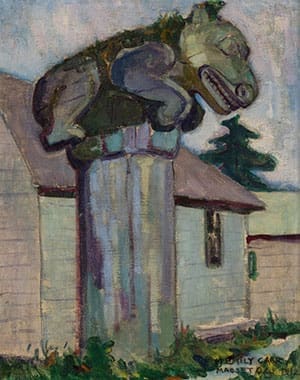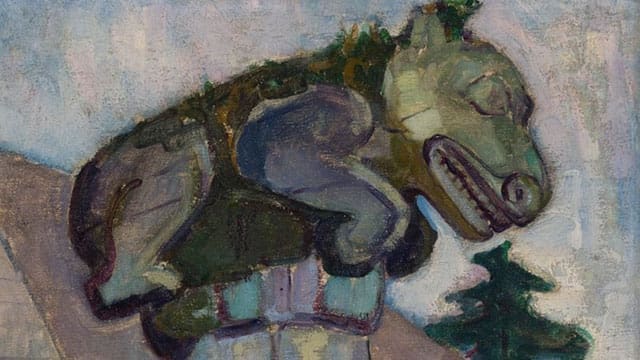The incredible story of a lost Emily Carr painting found in a barn after nearly a century

For interview requests, click here
Some big news occurred in the world of Canadian art. A painting by Emily Carr, one of this country’s finest artists, recently sold at a Toronto auction for well above the asking price.
“That’s interesting,” some readers may be thinking, “but what makes it interesting?”
What if I told you that Carr’s painting was unknown, had been hanging on a wall in another country for nearly a century, and was found by chance at a sale in a barn?
Well, then. That would make it one of the most interesting stories involving a piece of Canadian art of all time!
It begins with Allen Treibitz, a New York-based art dealer for 40 years. He happened to go to a barn sale in the Hamptons, a beautiful seaside resort in Long Island that’s more commonly associated with large homes and wealthy individuals. And there, hanging in the barn rafters, was the painting that first attracted his notice.
“It stood out from everything else in that barn,” Treibitz told the Canadian Press on Oct. 2. He had no idea who the painter was, or any knowledge about the subject material. The only details he had were the signature, size (41 cm by 33 cm), date (1912) and title (Masset, QCI). A Nov. 20 CBC article included these additional tidbits. “The person (who) owned the painting had died, there were no heirs and the contents of the barn were being sold. [Treibitz] said he found out it was on the property for about 90 years.”
| Recommended |
| The legacy of St. Anne’s Anglican Church and the fire that changed it all
|
| Quebec artist bears witness to Africa’s climate migrants
|
| How Canada can lead the way in preventing art vandalism
|
The price? A bargain: US$50, or C$69.60 as of Nov. 25.
“It had a look. It was very special, stood out from other things in that barn, and quite frankly, stood out from most of the things that we see,” Treibitz said. “Other than that, how it ended up … on that property, I don’t think anybody could ever know. If I didn’t find it, it might never have been found.”

Emily Carr, Masset, QCI
Image courtesy Heffel Fine Art Auction House.
He soon discovered it was “far more valuable than what he paid,” according to an Oct. 2 New York Post article. Treibitz contacted David Heffel, president of Toronto’s Heffel Fine Art Auction House. “We were provided photos and there was no doubt in my mind that this was an exciting Cinderella discovery,” Heffel told CP. The painting “was deemed an authentic work” by Carr, noted The Art Newspaper on Oct. 3.
Carr is widely regarded as one of Canada’s greatest post-Impressionist painters. She studied art in Canada and the U.S., worked in France, was associated with the Group of Seven, and lived among several Indigenous communities, including the Nuu-chah-nulth people, who gave her the name Klee Wyck (Laughing One). She treasured this name, which became her first book’s title.
Carr’s sketches and paintings of Indigenous scenes and totem poles are among the most important of her body of work. Masset, QCI depicts an Indigenous memorial post with a carving of a grizzly bear on top. There are small homes and a single tree in the background. This memorial post was located in the village of Masset, on B.C.’s Haida Gwaii archipelago – or Queen Charlotte Islands, if you like.
How did Carr’s painting end up in the Hamptons? That’s an interesting story, too.
“The piece is believed to have been a gift to Carr’s friend Nell Cozier and her husband in the 1930s,” according to CP, “and has been hanging in a barn in the Hamptons since.” The Art Newspaper noted that Cozier and her husband, “originally from Carr’s longtime home of Victoria, British Columbia … had moved to the Hamptons for work on a large estate.” The painting had an inscription on the back, Miss Carr/chez R. Charbo 96 Bvld Montparnasse. This is a “likely reference to Carr’s time spent studying in Paris around 1910-11.”
Here’s another fascinating detail. Carr painted a different version of this scene, Bear Totem, Masset, QCI, in 1937, currently housed in Victoria’s B.C. Archives. While it’s not surprising to learn the great artist would have painted another perspective of this totem pole, the fact that no one knew about it until recently is rather extraordinary.
“It’s a long lost treasure,” according to CBC’s Nov. 20 interview with auction house vice-president Robert Heffel. “Emily Carr is one of Canada’s most important artists. This painting is a really great example of her work from 1912, in full colours, when she came back to Canada from studying in France. It’s just a real great find.”
The auction attendees seemingly agreed. The presale estimate for Masset, QCI, was between $100,000 and $200,000. The hammer price was $290,000 – which, after the buyer’s premium and commission to Heffel were factored in, brought the final amount to $349,250. The buyer’s name hasn’t been identified, but Heffel said it was a “passionate collector” and good client.
The odds of finding an unknown painting by a well-known Canadian artist at a barn sale in the upscale Hamptons by an American art dealer are next to nil. Nevertheless, a one-in-a-million opportunity, a good eye and a hunch brought a national treasure back to the Great White North – and earned a small fortune.
It’s an art story that will never be replicated.
Michael Taube is a political commentator, Troy Media syndicated columnist and former speechwriter for Prime Minister Stephen Harper. He holds a master’s degree in comparative politics from the London School of Economics, lending academic rigour to his political insights.
Explore more on Arts and Entertainment, Painting
The views, opinions, and positions expressed by our columnists and contributors are solely their own and do not necessarily reflect those of our publication.
© Troy Media
Troy Media is committed to empowering Canadian community news outlets by providing independent, insightful analysis and commentary. Our mission is to support local media in building an informed and engaged public by delivering reliable content that strengthens community connections, enriches national conversations, and helps Canadians learn from and understand each other better.

